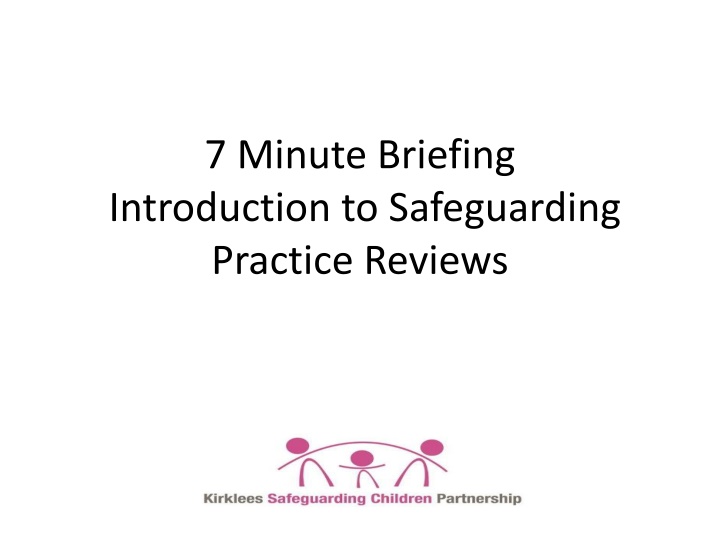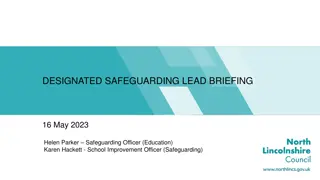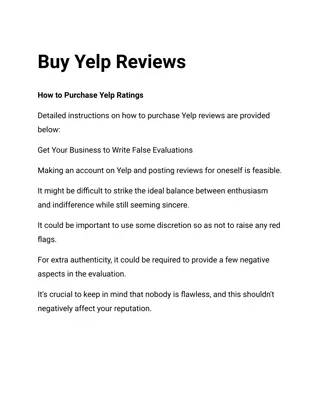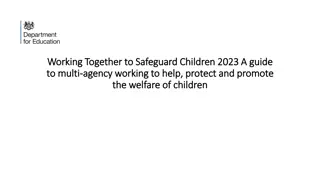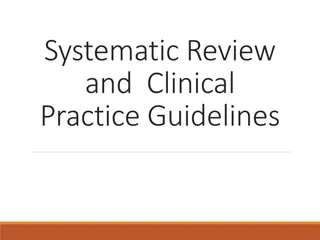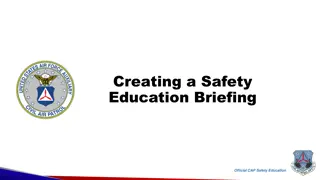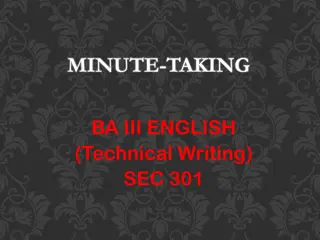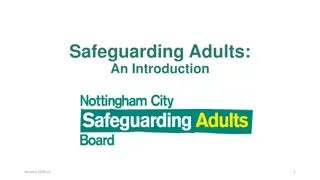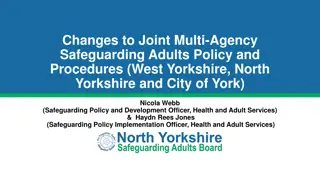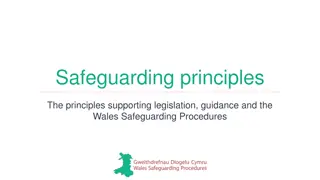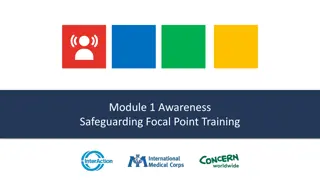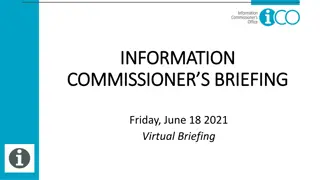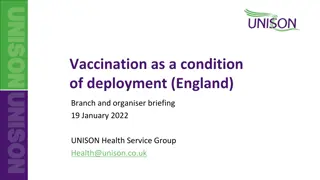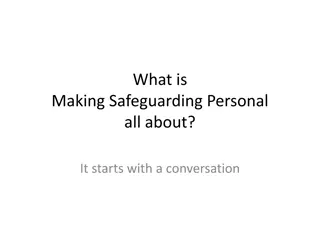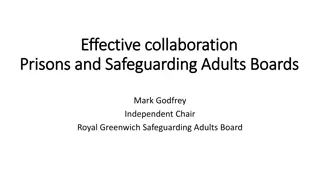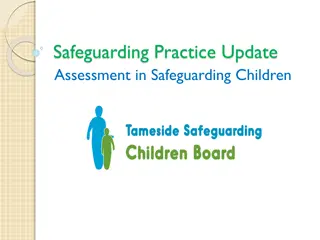7-Minute Briefing Introduction to Safeguarding Practice Reviews
This brief overview emphasizes the importance of conducting Safeguarding Practice Reviews to learn from both successful operations and failures in safeguarding children, as laid out in the "Working Together to Safeguard Children (2018)" guidance document. It stresses the need for transparent and objective analysis to improve services and reduce harm to children in the future.
Download Presentation

Please find below an Image/Link to download the presentation.
The content on the website is provided AS IS for your information and personal use only. It may not be sold, licensed, or shared on other websites without obtaining consent from the author.If you encounter any issues during the download, it is possible that the publisher has removed the file from their server.
You are allowed to download the files provided on this website for personal or commercial use, subject to the condition that they are used lawfully. All files are the property of their respective owners.
The content on the website is provided AS IS for your information and personal use only. It may not be sold, licensed, or shared on other websites without obtaining consent from the author.
E N D
Presentation Transcript
7 Minute Briefing Introduction to Safeguarding Practice Reviews
Working Together to Safeguard Children (2018) Is a guidance document for everyone working with children and families. This guidance covers: the legislative requirements and expectations on individual services to safeguard and promote the welfare of children; and a clear framework for Local Safeguarding Children Partnerships (LSCPs) to monitor the effectiveness of local services.
It states that professionals and organisations protecting children need to reflect on the quality of their services and learn from their own practice and that of others. Good practice should be shared so that there is a growing understanding of what works well. Conversely, when things go wrong there needs to be a rigorous, objective analysis of what happened and why, so that important lessons can be learnt and services improved to reduce the risk of future harm to children. These processes should be transparent, with findings of reviews shared publicly. A Safeguarding Children Partnership must undertake a Safeguarding Practice Review whenever a child dies, and where abuse or neglect are known, or suspected to be, a factor in the death. Safeguarding Children Partnerships are also required to consider, and may choose to undertake a Safeguarding Practice Review in circumstances where a child is seriously injured as a result of abuse or neglect (which includes suicide), and where the case gives rise to concerns about the way in which local professionals or agencies worked together to safeguard and promote the welfare of the child.
There are specific criteria which, if met, indicate that a serious practice review should be undertaken. It is the responsibility of the Safeguarding Children Partnership to undertake the reviews of serious cases and to advise Partners and the local authority on lessons to be learned. A serious case is one where: Abuse or neglect of a child is known or suspected and The child has died or been seriously harmed Serious harm includes (but is not limited to) serious and/or long-term impairment of a child s mental health or intellectual, emotional, social or behavioural development. It should also cover impairment of physical health.
The purpose of a Safeguarding Practice Review is to enable the work of agencies to be scrutinised and analysed, in order to establish whether there are lessons to be learned from the case about the way in which local professionals or agencies worked together to safeguard and promote the welfare of the child. If the Safeguarding Practice Review does identify lessons to be learned, there is a requirement to implement plans in order to act on these lessons in order to safeguard children more effectively in the future. They should provide a sound analysis of what happened in the case, and why, and what needs to happen in order to reduce the risk of recurrence Safeguarding Practice Reviews are not a blaming exercise the process can identify failings of individual staff as well as systems, procedures and organisations. Therefore, there can sometimes be implications for individuals, and it is not unknown for the Safeguarding Practice Review process to influence processes such as disciplinary or capability.
Principles for Conducting a Safeguarding Practice Review There should be a culture of continuous learning and improvement across the organisations that work together to safeguard and promote the welfare of children, identifying opportunities to draw on what works and promote good practice; The approach taken to reviews should be proportionate according to the scale and level of complexity of the issues being examined; Reviews of serious cases should be led by individuals who are independent of the case under review and of the organisations whose actions are being reviewed; Professionals must be involved fully in reviews and invited to contribute their perspectives without fear of being blamed for actions they took in good faith; Families, including surviving children, should be invited to contribute to reviews. They should understand how they are going to be involved and their expectations should be managed appropriately and sensitively. This is important for ensuring that the child is at the centre of the process; Final reports of SPRs must be published, including the LSCB s response to the review findings, in order to achieve transparency. The impact of SPRs and other reviews on improving services to children and families and on reducing the incidence of deaths or serious harm to children must also be described in LSCB annual reports and will inform inspections; and Improvement must be sustained through regular monitoring and follow up so that the findings from these reviews make a real impact on improving outcomes for children.
Safeguarding Practice Reviews and other case reviews should be conducted in a way which: Recognises the complex circumstances in which professionals work together to safeguard children; Seeks to understand precisely who did what and the underlying reasons that led individuals and organisations to act as they did; Seeks to understand practice from the viewpoint of the individuals and organisations involved at the time rather than using hindsight; Is transparent about the way data is collected and analysed; and Makes use of relevant research and case evidence to inform the findings.
The Safeguarding Children Partnership should oversee the process of agreeing with partners what action they need to take in light of the SPR findings, establish timescales for actions to be taken, agree success criteria and assess the impact of the actions. All reviews of cases meeting the SPR criteria should result in a report which is published and readily accessible on the Safeguarding Children Partnership website for a minimum of 12 months. Thereafter the report should be made available on request. This is important to support national sharing of lessons learned and good practice in writing and publishing SPRs. From the very start of the SPR the fact that the report will be published should be taken into consideration. SPR reports should be written in such a way that publication will not be likely to harm the welfare of any children or vulnerable adults involved in the case.
KSCP Information Website - https://www.kirkleessafeguardingchildren.co.uk/ Twitter - @KirkleesLSCP Telephone 01484 225161
